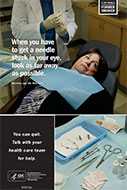Vision Professionals: Help Your Patients Quit Smoking

You can play a key role in fighting tobacco use, the number one cause of preventable death and disease in the United States. You know the drastic effects that smoking can have on your patients’ eye health. You see the toll smoking can have on vision. Many smokers want to quit. And your patients trust you. Getting started often takes support and motivation from trusted sources, like you.
When it comes to talking to patients about quitting tobacco use, the Tips From Former Smokers® (Tips®) campaign can be a conversation starter. The campaign offers resources for you as well as your patients. With the support of CDC’s materials, you can help more patients live smokefree lives.
I’m ready to help my smoking patients quit. How can I get started?
Congratulations on your dedication! Following are some resources to help you with this very important work:
- Fact sheet about Tips [PDF – 1M] and how health care professionals can get involved and support patients
- Free continuing education training for up to 4.5 CEs, entitled “Smoking Cessation for Pregnancy and Beyond: A Virtual Clinic”
- FAQs for Health Care Providers
- FAQs about how quitlines work and their effectiveness
- A printable, pocket-sized tobacco intervention card [PDF – 69K] that lists the steps for conducting a brief tobacco intervention with your patients
- Medscape video (Conducting a Brief 2A Tobacco Intervention) An informational video featuring Tim McAfee, MD, director of CDC’s Office on Smoking and Health. This video shares the steps that you can take to conduct brief interventions with your patients.
- Medscape video – HIV and Smoking John Brooks, MD, Leader of the HIV Epidemiology Research Team at the CDC’s Division of HIV/AIDS Prevention explains the added dangers of smoking with HIV, and what steps you can take to help your patients.
- HIV Provider Smoking Cessation Handbook: A Resource for Providers
- HIV & Tobacco Use: Pharmacologic and Behavioral Methods to Help Your Patients Quit [PDF – 282KB]
- Tips From Former Smokers Download Center for videos to show in your waiting room, radio ads, print ads, and more free resources
How Can I Help My Patients Become Smokefree?

- Download “Talk With Your Health Care Team” posters to inspire your patients to quit (in English or Spanish). Hang them in your practice’s waiting room, in patient rooms, and throughout your offices, where patients will see them every day.
- Download videos, print ads, radio ads, and other Tips campaign materials from the Tips Download Center to show in your waiting room. All of these resources are free for you to use.
- Order free notepads (with the 1-800-QUIT-NOW quitline number and CDC logo) to use in your practice (enter “notepad” in search bar on publication catalog web page).
- Explain how smoking is linked to vision loss . Use Marlene from the Tips campaign to provide an example of what can happen to patients.
- Suggest that your patients visit the I’m Ready to Quit page on the Tips Web site. Link to it from your practice’s Web site.
Let your patients know that they can get free quit help by calling 1-800-QUIT-NOW (1-800-784-8669) or 1-855-DÉJELO-YA (1-855-335-3569) (for Spanish speakers).
Professional Resources for Vision Care Professionals and Patients
- The 2014 Surgeon General’s Report: The Health Consequences of Smoking—50 Years of Progress documents eye diseases that are linked smoking, including age-relate macular degeneration and smoking. Chapter 10 [PDF-5.2 MB] specifically addresses these vision loss-related conditions.
- Prevent Blindness has several resources for vision care professionals and patients, including:
See Jane See—Women’s Healthy Eyes Now
Age-Related Macular Degeneration
Healthy Living, Healthy Vision
Smoking and Vision Fact Sheet [PDF-178KB]
- The National Eye Institute has Healthy Vision Month resources for use in your practice, as well as resources about conditions linked to smoking, including Facts About Cataract and Facts About Age-Related Macular Degeneration.
- CDC’s Vision Health Initiative promotes vision health and quality of life for all populations, through all life stages, by preventing and controlling eye diseases, eye injury, and vision loss resulting in disability.
Other Resources
- Treating Tobacco Use and Dependence: A Quick Reference Guide for Clinicians
This quick reference guide summarizes the findings from the Clinical Practice Guideline Treating Tobacco Use and Dependence: 2008 Update, including:
- A summary of evidence-based cessation treatments
- A description of the development process
- Thorough analysis and discussion of the available research
- Critical evaluation of the assumptions and knowledge of the field
- Information for health care decision making
- The Community Guide
The Guide to Community Preventive Services is a free resource to help you choose programs and policies to improve health and prevent disease in your community. It includes systematic reviews of tobacco prevention and control interventions in the following areas:
- Youth prevention
- Cessation
- Exposure to secondhand smoke
- Minors’ access to tobacco products
- Tobacco use among workers
- Mass-reach health campaigns
- Prevent Blindness
Founded in 1908, Prevent Blindness is the nation’s leading volunteer eye health and safety organization dedicated to fighting blindness and saving sight. Focused on promoting a continuum of vision care, Prevent Blindness touches the lives of millions of people each year through public and professional education, advocacy, certified vision screening and training, community and patient service programs, and research. For more information on smoking and eye health, visit preventblindness.org/smoking.
- Page last reviewed: March 6, 2017
- Page last updated: July 28, 2017
- Content source:


 ShareCompartir
ShareCompartir